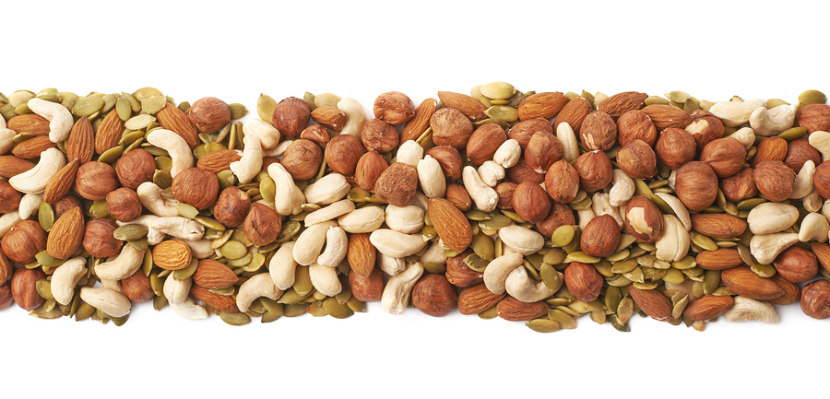
Nuts and seeds are a tasty way to eat more heart healthy nutrients such as fibre and unsaturated fat. They can help to add variety and flavour to your meals so that eating is even more nut-ritious!
Why are nuts and seeds good for your health?
-
The fat found in nuts and seeds is mostly the unsaturated type, which may help to reduce your risk of developing heart disease.
-
They are also cholesterol free, which is important in a heart healthy diet.
-
Nuts and seeds have fibre, which keeps your bowels healthy and will also help make you feel full (important if you’re trying to manage your weight).
-
They are a good source of protein, which fills you up and keeps your muscles strong.
-
Many nuts and seeds contain antioxidants, which may help to protect against some diseases like cancer and heart disease.
-
These delicious snacks are included in the Meat and Alternatives group of Canada’s Food Guide, so they fit perfectly into any healthy eating plan.
How many nuts and seeds should I have?
One serving of nuts or seeds is about a ¼ cup or 60 mL. This amount should just fit into the palm of your hand.
If you prefer to use nut butters or spreads, one serving is equal to 2 tablespoons. This amount is about the size of your two thumbs.
Nuts and seeds are healthy choices, but be careful not to over do it. They are high in fat so the calories can add up quickly!
Choose nuts that are raw or dry roasted (without oil) and free of added salt and sugar to make sure that you are picking the most heart healthy option.
What is the nutrient content of some common nuts and seeds?
The nutrition information listed in this table is for one serving (1/4 cup/ 60ml) of the nut or seed.
|
Calories (kcal)
|
Protein (g)
|
Total Fat (g)
|
Unsaturated Fats (g)
|
Fibre (g)
|
|
Nuts
|
|
Almonds
|
208
|
8
|
18
|
16
|
4
|
|
Brazil
|
233
|
5
|
24
|
16
|
3
|
|
Cashews
|
182
|
6
|
14
|
11
|
1
|
|
Hazelnuts
|
189
|
4
|
18
|
16
|
3
|
|
Macadamia
|
244
|
3
|
26
|
21
|
3
|
|
Peanuts
|
210
|
10
|
18
|
15
|
3
|
|
Pecans
|
173
|
2
|
18
|
15
|
2
|
|
Pine
|
230
|
5
|
23
|
18
|
1
|
|
Pistachios
|
174
|
6
|
14
|
11
|
3
|
|
Walnuts
|
166
|
4
|
17
|
14
|
2
|
|
Seeds
|
|
Chia *
|
147
|
5
|
9
|
7
|
13
|
|
Flax
|
225
|
8
|
18
|
16
|
12
|
|
Pumpkin
|
189
|
9
|
16
|
12
|
1
|
|
Sesame
|
225
|
8
|
21
|
17
|
5
|
|
Sunflower
|
208
|
8
|
18
|
15
|
4
|
*Chia (or Salba) seeds are white or black seeds that are similar to flax seeds and can be found in the natural food section of your grocery store.
Did you know? Peanuts are not actually nuts! They are a member of the legume family and grow underground as part of a root system.
How do I use nuts and seeds?
Are you tired of peanut butter? Do you want new ideas for adding nuts and seeds to your diet? Nuts and seeds can be found whole, chopped, flaked or ground up into flour or nut butters. There are so many different ways to add nutty goodness to your meals and snacks. Give these ideas a try:
-
Try different nut and seed butters on your sandwiches. Cashew nut or sunflower seed butter can take your sandwich to a new level!
-
Increase the flavour of nuts by lightly toasting them. Place nuts in a dry frying pan over medium to high heat for 3-5 minutes. Nuts can burn quickly, so watch them carefully.
-
Spread tahini (from ground sesame seeds) on crackers or use it as a dip with fresh veggies. It is often found in hummus, but it is tasty on its own too.
-
Add crunch to fish fillets by sprinkling on chopped nuts like almonds or pine nuts before baking.
-
Sprinkle flax or chia seeds on yogurt, cereal or salads for some added fibre.
Recipes
Fibre Power Biscotti, Dietitians of Canada
Banana Nut Smoothie
Coconut Curry Cashew Chicken
Oat Flax Pancakes with Steamed Cinnamon Apples
For more information:
Pumpkins
Vegetarianism FAQs
Phytonutrients – Nature’s Natural Defence
Last Update – January 30, 2019